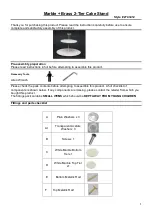
41
EVERYTHING RIDES ON IT
Studies of tire safety show that maintaining proper tire
pressure, observing tire and vehicle load limits (not
carrying more weight in your vehicle than your tires or
vehicle can safely handle), avoiding road hazards, and
inspecting tires for cuts, slashes, and other irregularities
are the most important things you can do to avoid
tire failure, such as tread separation or blowout and
flat tires. These actions, along with other care and
maintenance activities, can also:
Improve vehicle handling
Help protect you and others from avoidable breakdowns
and accidents
Improve fuel economy
Increase the life of your tires.
This booklet presents a comprehensive overview of tire
safety, including information on the following topics:
Basic tire maintenance
Uniform Tire Quality Grading System
Fundamental characteristics of tires
Tire safety tips.
Use this information to make tire safety a regular part
of your vehicle maintenance routine. Recognize that
the time you spend is minimal compared with the
inconvenience and safety consequences of a flat tire or
other tire failure.
SAFETY FIRST–BASIC TIRE MAINTENANCE
Properly maintained tires improve the steering,
stopping, traction, and load-carrying capability of your
vehicle. Under-inflated tires and overloaded vehicles are
a major cause of tire failure.
Therefore, as mentioned above, to avoid flat tires and
other types of tire failure, you should maintain proper
tire pressure, observe tire and vehicle load limits, avoid
road hazards, and regularly inspect your tires.
FINDING YOUR VEHICLE’S RECOMMENDED TIRE
PRESSURE AND LOAD LIMITS
Tire information placards and vehicle certification labels
contain information on tires and load limits. These
labels indicate the vehicle manufacturer’s information
including:
Recommended tire size
Recommended tire inflation pressure
Vehicle capacity weight (VCW–the maximum occupant
and cargo weight a vehicle is designed to carry)
Front and rear gross axle weight ratings (GAWR– the
maximum weight the axle systems are designed to
carry).
Both placards and certification labels are permanently
attached to the vehicle door edge, door post, glove-
box door, or inside of the trunk lid. You can also find
the recommended tire pressure and load limit for your
vehicle in the vehicle owner’s manual.
TIRE SAFETY
The following information has been acquired from the
NHTSA website.
Summary of Contents for 2020 TOFINO
Page 1: ...1 OWNER S MANUAL 2020 TOFINO Ram ProMaster 1500 ...
Page 6: ...6 ...
Page 11: ...5 ...
Page 34: ...28 DC LOAD CENTER BOARD SPYDER CONTROLS ...
Page 53: ...47 MAINTENANCE LOG MODEL YEAR VIN DATE PURCHASED DATE WORK PERFORMED BY MILEAGE NOTES ...
Page 54: ...48 DATE WORK PERFORMED BY MILEAGE NOTES ...










































